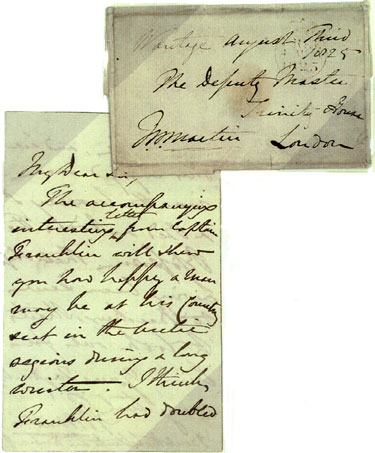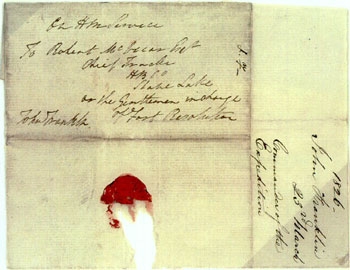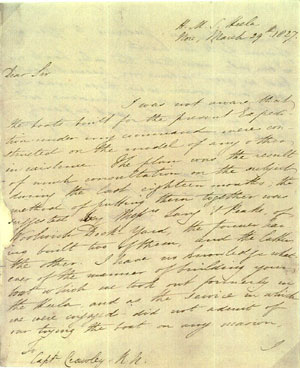
Beechey explored the northern coast of Alaska in 1825.
Publication of scientific observations became the trail of information that supported later work.
A Postal History Gallery of Related Events
1825-29
Frederick William
Beechey
1825
 |
Beechey explored the northern coast of Alaska in 1825. Publication of scientific observations became the trail of information that supported later work. |
A Shared Letter
1825
 |
May 4, 1825 . . .
The accompanying letter from Franklin will show how happy a man may be at his country seat in the Arctic regions during a long winter. J. Martin
Letters from highly regarded Arctic parties were shared with friends. This letter went on to assume he was picked up by an auxiliary vessel near the Bering Strait. He had actually turned back to cross Canada again to the east coast due to problems with the weather and the natives. |
John Franklin
Overland Through Central Canada
1826
 |
Sir John Franklin explored central Canada in 1826 and traveled into Alaska where he named Prudhoe Bay on Alaska's north slope. Messages and mail was returned by Indian couriers to the Chief Trader at Great Slave Lake. Regular mail service was not available. |
A Charge Of Design Copying
1827
 |
An accusation that Captain Parry used a private design in constructing landing craft was rejected outright. |
|
John Ross A Voyage of Discovery "The 23rd of May (1829) having been at length fixed for our departure, I attended at the Admiralty, and took my leave. Arriving at Woolwich, I found my excellent friend Byan Martin, Comptroller of the Navy, and Sir John Franklin on board . . . , if the inspection of the arrangements was a source of gratification to our visiters, my friends were as little satisfied as myself with what I had long anticipated." * Thus were the feelings of John Ross as he was about to start his second Arctic Expedition. His ship, the Victory, which was formerly a packet between the Isle of Man and Liverpool, was selected in order to utilize her steam engine. Ross was to become the first man to explore in the arctic in a steam driven vessel. "The stores of provision and fuel were for a thousand days; the former being of the best quality, and containing a proportion of preserved meats . . .," * The volunteer crew included Ross's nephew, Commander James Clark Ross, as second-in-command. This was to be the second visit to the arctic for Ross since he shared a command with Parry in 1818 when they sailed the ISABELLA and TRENT into Lancaster Sound; due to a combination of circumstances Parry returned home with a heroes welcome while Ross was blamed for their failure to investigate the far end of Lancaster Sound where, opinion held, lay the Northwest Passage. A successful voyage was now essential to his career which started in 1786 at the age of nine years. His first assignment was as cabin boy to Sir James Saumerez and he served many years with him, being wounded thirteen times in three actions. The illustrated cover below provides an interesting polar connection since it is from General Thomas Saumerez, Sir James' brother, responding to a request from Ross for assistance in a special matter. A close kinship must have maintained between the families and a river, which never freezes, in latitude 70° North, longitude 92° West, which was named for them. The letter itself was directed to the H.M.S. DILIGENCE which was to serve fifty years later as a supply ship in the Franklin rescue operations.
His Patron was Remembered
This second expedition was privately financed with the principal support from Sheriff Booth of London. Still, Ross planned that after caching supplies at Prince Regents Inlet the auxiliary vessel John would salvage the supply depot left by Parry in 1824 as well as to fish, by the way in order to compensate his patrons in some way. Ross's journal of the voyage set out his preliminary arrangements as follows: "In March, 1829, I addressed letters to the several learned societies signifying my intentions and requesting to know in what manner I could aid them in their several projects of pursuit; receiving from each such answers as they thought proper. My last applications was to the different foreign ambassadors with a request to be considered neutral in case of war; on which passports were readily granted; while the treasury issued an order for the remission of duties on such articles embarked in the vessel as were subject to impost." *
The voyage was far from an easy one since the steam engine operated only with difficulty from the beginning and extra shifts were necessary on the pumps to offset the leakage in the boilers. In June 1829, Ross wrote from Douglas Bay and the Calf of Man for machinery replacements, but the requested equipment never caught up with them rendering the engine almost useless, eventually forcing them to jettison it. But the greatest setback came at Loch Ryan when Ross learned that the crew of the JOHN refused to sail due to the lateness of the season -- Ross was unable to change their decision and wrote at least four letters pertaining to the "Mutiny at Loch Ryan," and departed without the services of his supply ship. The final mails were dispatched from Holstenborg, Greenland in July via a Danish ship. The details of the expedition from this point are history since they wintered an unprecedented four years in the arctic with only three fatalities, one by arctic causes. They determined the northern extremity of North America charting five hundred miles of territory around this point and James Clark Ross led an overland expedition to the North Magnetic Pole. In 1950 two relics of this visit were found by Eskimos near the Hudson's Bay Company post at Spence Bay on Boothia Peninsula. The first was a small brass cannon, probably left when the ship was lightened in an attempt to break out of the ice in 1832. The second item was a wooden leg, undoubtedly the one made by the carpenter of the VICTORY for the Eskimo Tulluahin in return for assistance from the villagers in mapping the area. The story of the wooden leg had been passed down through the years by these people whose only other contact with outsiders until recent years was a visit by Roald Amundsen during his navigation of the Northwest Passage in 1906. Tulluahin had used the skull of a musk-ox attached to the bottom of the leg for walking in deep snow. When the VICTORY failed to break out of the winter harbor of 1832 she was abandoned and the entire crew headed for the ocean in the small boats hoping to be picked up by a passing vessel. The futility of such an expectation seems apparent in afterthought, but when there is no other course such things are overlooked. When hope of rescue seemed most remote a ship was sighted that turned out to be the ISABELLA, Ross's old ship of 1818. She was searching for traces of the Ross party, rather than expecting to find them alive. The ISABELLA remained in the area several months more, surveying and charting fishing grounds, while letters were dispatched on passing whalers to announce the good news. Various official letters were dispatched by Captain Ross, such as the one below to Viscount Melville in Edinburgh, and dated "Sept. 1833". His official letters carried a large wax seal with a personal design, apparently used on his 1818 expedition since the center design shows the date as well as his name. This expedition vindicated him from earlier discredits.
* Narrative of a second voyage in search of a Northwest Passage; Sir John Ross; Paris, 1835.
|